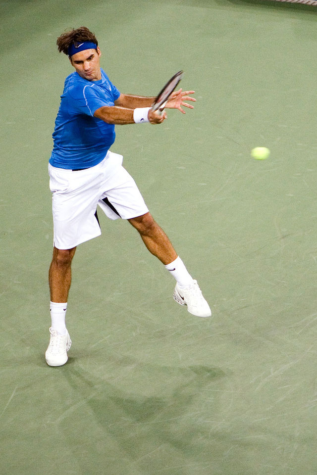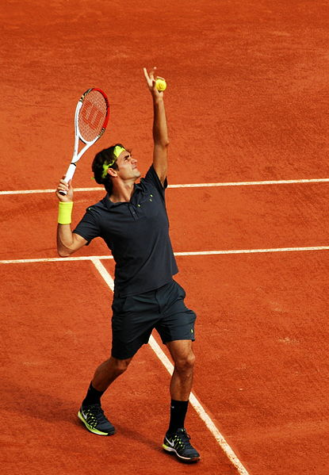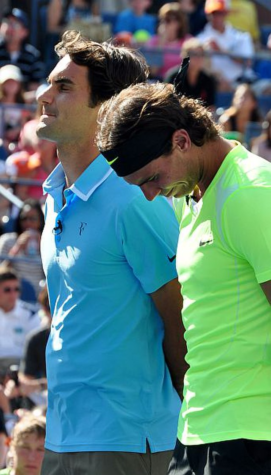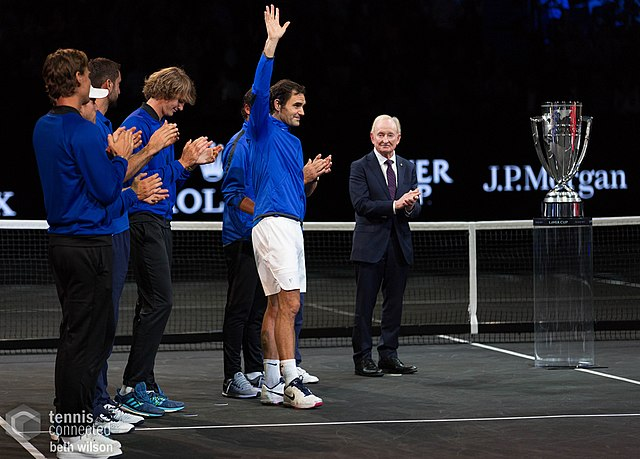24 Years and 20 Grand Slams Later, Federer Hits His Final Forehand
Whether it was through toying effortlessly with opponents on the court or being an incredible ambassador and presence off of it, Roger Federer’s 24 years of excellence on the ATP Tour has forever changed the sport.
SUF, CC BY-SA 4.0
After winning the inaugural Laver Cup in 2017, Federer graciously accepts the trophy. In 2022, he would retire at that very same event, alongside rivals and friends.
At a small pro tour event in Gstaad, a 16-year-old boy from Basel, Switzerland played his first-ever professional match. 24 years later, Roger Federer took his final bow. In that time, the Swiss Maestro left an undeniable mark and legacy on the sport, inspiring millions and changing the game of tennis forever.
Roger Federer’s illustrious career began with a meteoric rise to stardom. In 1999 at just age 17, Federer became the youngest player ever to be ranked inside the ATP (Association of Tennis Professionals) top 100. Just two years later, at the age of 19, Federer won his first ever ATP tournament, at the 2001 Milan Indoor. It was in 2003, however, when the floodgates opened. He finally broke through and captured his first major title at the Wimbledon Championships, as well as reaching nine finals and winning the year-end championship. In 2004, he established himself as undoubtedly the best player in the world, winning three of the four grand slams, three Masters 1000 events, and 11 total titles. He finished the year with a breathtaking 74-6 Win-Loss record and with the year-end No. 1 ranking comfortably in hand. Andy Roddick, who was defeated at Wimbledon that year and was one of Federer’s earliest rivals, said that with the level of confidence he had, a lot of his success was “between the ears.” This indication from Roddick suggested that the best was still yet to come.

From 2004-07, Federer experienced nearly unmatched dominance, setting the tour ablaze by winning 42 titles across that span. However, one surface, and more importantly, one person began to get in his way. Enter Federer’s greatest rival and friend, the player who he wished to retire next to — Rafael Nadal, the “King of Clay” court tennis.
Nadal was a young Spaniard who, like Federer, burst onto the scene at a young age. At the age of 19, he won the French Open on his first attempt. He would soon prove to be a worthy opponent for Federer, seemingly the one man who could get in the way of the Federer “freight train.” In their first meeting in 2004, Nadal pulled off a huge upset over Federer at the hard-court Miami Masters. However, the now undisputed “King of Clay” began to show his true dominance on the red surface beginning in 2005. For the next four years until 2009, Nadal proved to be a frustrating roadblock for Federer on a clay court, going 10-2 against him on the surface and defeating him four years in a row, and three times in a row in the final.

In 2009, the door swung wide open for Federer. Nadal faltered, uncharacteristically losing at the French Open to Robin Soderling. Federer took full advantage of this opportunity, ultimately defeating Soderling to win his first French Open title. Over the rest of their careers, Federer and Nadal’s rivalry only grew stronger, with multiple of their matches being dubbed as some of the greatest of all time. Along with Serbian Novak Djokovic, they formed the “Big 3” of tennis players, a group which, in the truest sense of the word, dominated the rest of the tour even to this day. Their control over the tour has all but blocked out any newcomers during their prime years, with Roddick saying, “I feel like those guys have taken away an entire generation of Grand Slam winners,” referring to players who in other eras would have multiple major wins.
One of the only hiccups in Fed’s career came from 2013-2016, when both he and Nadal struggled heavily with injuries, with Federer failing to win a title altogether in 2016 for the first time since 2000. However, his perseverance proved itself once again with a massive career resurgence in 2017. In January, Federer faced off against Nadal at the Australian Open final, prevailing in a 5-set thriller for the history books. He would go on to win Wimbledon and three Masters 1000 events on his way to a 7-title year and a 92% win rate, his highest since 2006. When prompted about it, former player-turned-coach Darren Cahill lamented “He shattered any concerns we had, and totally reset the bar on what might lie ahead for him.”
Federer won the final major of his illustrious career at the Australian Open in 2018 and would play his last complete season on tour in 2019. Although Fed’s magic with his Wilson wand never went away, his knee would ultimately cause the end of his remarkable career. After undergoing knee surgery twice in early 2020, Federer rehabilitated his way to a return to the sport for the French Open and Wimbledon in 2021. He would post a 9-4 record on the year, ending with a straight-sets defeat in what would be his last-ever singles match to Hubert Hurcacz.
On September 15th, 2022, Roger Federer officially announced his retirement from the sport. His final match was to be played at the Laver Cup, a team event that he helped found in 2017, alongside rival and friend Rafael Nadal. Federer and Nadal faced off against Americans Frances Tiafoe and Jack Sock, ultimately losing 11-9 in a 3rd set tiebreak. The unique nature of the Laver Cup meant that Federer was surrounded by the best players in the world, some of them having grown up watching his career unfold. As such, his incredible career culminated in a celebration of epic proportions, a retirement unlike anything the sport had ever seen. With tribute videos and emotional interviews, the Swiss, and even Nadal, couldn’t contain their emotions. However, even with tears streaming down his face, Federer insisted, “I’m happy, I’m not sad.”

Even with the sun setting on his career, his impact on the sport is what truly immortalizes him as one of the greatest athletes ever. When I interviewed Leo Correa, High-Performance Coach at the USTA Billie Jean King National Tennis Center, for this article on Federer’s career, Correa said, “We have seen Federer transform from a hot-headed teenager into a player who has made history and transcended the sport.” In fact, it is almost unbelievable to conceive that the long-haired short-tempered boy who regularly broke racquets turned into the most level-headed and respected player in all of tennis.
The grace that Federer demonstrated when playing the sport, and the effortless manner in which he performed such physically demanding shots were some of his signature qualities and one of the factors that contributed to his massive fandom. “Roger Federer played the game the way it was meant to be played, but in a way no one else could,” said 17-year-old Rahul Vasudev, a member of Hunter High School’s Varsity Tennis Team.
In fact, the effortlessness that he demonstrated on the court led many to attempt to emulate his style of play, from his forehand all the way to his signature shots such as the tweener and SABR (Sneak Attack By Roger). Many players, ranging from casual to top professionals in the world today, have modeled their game and technique after Federer’s example. “Attempting to emulate various aspects of his game is really what catalyzed my passion for tennis. The composure and grace he displayed on the court, as well as the elegance he showed off the court was simply unmatched and served as my primary source of inspiration,” said Luke Ellerstein ’23, a member of Bronx Science’s Varsity Tennis Team. As for professionals, both former World No. 3 Grigor Dimitrov and current World No. 5 Stefanos Tsitsipas have attributed their use of a one-handed backhand to watching and idolizing Federer as they grew up.
Federer’s presence in the sport will remain, helped in part by his participation in the founding of the Laver Cup. The unique team competition was created in 2017 and pitted 2 teams (Team World and Team Europe), against each other in a 3-day long team event. Since then, Federer has participated in four of the first five iterations of the event for team Europe and has recruited top players in the world such as Nadal, Djokovic, Tsitsipas, and more to join him.
However, Federer insisted that this wouldn’t be the last time he picks up a racquet, hinting at possible exhibition matches with Nadal. One of these such rumored events is an exhibition set to take place in the Santiago Bernabeu stadium between the two titans of the sport. As noted by Adam Kamenetz ’23, another member of the Bronx Science Tennis Team, “While the sport lost him as a player, it has not lost him as a presence.”
In order to truly understand his impact on the sport, one can look to his off-court endeavors to grasp an understanding. He was an advertiser’s dream, garnering sponsors from big brands such as Rolex and Mercedes-Benz. During his longtime partnership with Nike, Federer created his own signature “RF” insignia and was the face of the company’s tennis line, until his departure to Japanese apparel brand Uniqlo in 2018. In 2020, Federer joined the Swiss shoe company On Running as a partner and entrepreneur. Since then, he has developed his own signature line of off- and on-court shoes and has increased the popularity and exposure of the company in countries such as the U.S. and Japan, as well as countries all across Europe.
As early as 2003, when Federer’s stardom truly began, he started the Roger Federer Foundation, a charity that provides support for parents and children in local communities for good education. As of 2021, the foundation has reached and changed the lives of nearly 2 million kids.
For a man with a magic wand for a racquet and a heart of gold, it will forever be difficult to sum up Roger’s incredible career and legacy. From a 17-year-old long-haired Swiss newcomer playing in Gstaad to the winner of 20 Grand Slams, 103 total titles, and 310 weeks as the world’s #1, the entire sporting world is forever indebted to one of the greatest athletes of all time. Thank you, Roger.
“Roger Federer played the game the way it was meant to be played, but in a way no one else could,” said 17-year-old Rahul Vasudev, a member of Hunter High School’s Varsity Tennis Team.
Sebastian Rosero-Mayer is a Sports Editor for ‘The Science Survey.’ He enjoys writing journalistic articles, as it allows him to share his ideas on...

